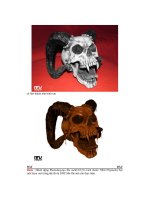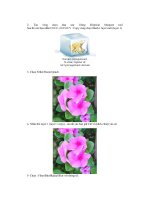Unity pro training bản tiếng việt
Bạn đang xem bản rút gọn của tài liệu. Xem và tải ngay bản đầy đủ của tài liệu tại đây (14.41 MB, 1,044 trang )
Module 1
Unity Pro Overview
June 2009
What is Unity Pro ?
Unity Pro is a SoCollaborative software for “end user”
platforms
Quantum, Premium, Atrium and Modicon M340
The Scalability of the software is based on the supported
platforms and not on features
Unity Pro Small supports only Modicon M340 PLCs
Unity Pro for all the life cycle of your project
Design
Schneider Electric
- Training – M RUIZ – January 2009
Debug
Operation
Maintenance
2
Selection Guide
XL
L
Unity Pro S M
XLS
Modicon M340
57-00
57-10
57-20
57-30
57-20
57-30
31110
Schneider Electric
- Training – M RUIZ – January 2009
43412
57-40
57-50
53414
65150
65x60
67160
65160S
67160S
3
Offer Structure
Single and multi-seats
Up to
Single
Unity Pro X Large
Unity Pro Large
Unity Pro Medium
Unity Pro Small
3 ……….10 ………...100 users
Group
Team
Facility
Upgrades
Ease to make transition path from legacy software (PL7,
Concept, ProWorx) for customers with active subscription only
Education and Schneider Alliance special offer
Schneider Electric
- Training – M RUIZ – January 2009
4
Presentation
The right tool for all phases of your project
Design : structured variables, libraries of FFBs
and 5 IEC languages to develop your application
program
Debug : a PLC simulator and high level of debug
services to test and debug your program
Operation : operator screens and diagnostic
viewer to monitor and control your process
Maintenance : on-line modifications to update
your application program
Openness : use of XML format / Advantys island
saved in the project / more collaborative solutions
/ Hardware catalog manager
Schneider Electric
- Training – M RUIZ – January 2009
5
Design your Program
Unity Pro is a full featured software package
Design
All platforms benefit of the whole richness of the features
5 IEC languages
Standardization capabilities
Through data : unlocated variables, structures and arrays
Through program : sections of program, user function blocks,
functional modules
Multitasking capabilities
MAST, FAST and AUX tasks
Event triggered treatments
Functional view to map your application to the process
With the possibility to bring more value through the openness
Interface to any client application through XML format
Schneider Electric
- Training – M RUIZ – January 2009
6
Debug your Application
Embedded PLC simulator
Debug
No hardware constraints to debug your program
Provide the same execution capabilities as a PLC
Possibility to use function blocks of IO management library to simulate
%I, %IW, %ID and %IF inputs (WRITE_INPUT_EBOOL,
WRITE_INPUT_INT, …)
An large set of debug services
Power flow animation for graphical languages
Breakpoint and step by step to test and debug the program
Watch point to know the real time value of a variable
SFC monitoring of step activity times
Color used during execution progress (boolean variables, steps,
transitions, …)
Schneider Electric
- Training – M RUIZ – January 2009
7
Operate and Maintain your Application
Visualize and control the application with operator screens
Graphical and animated view of your process
Operation
PLC and module diagnostic through configuration editor
Integrated system and application diagnostic accessible
through the built-in diagnostic viewer
Maintenance
No programming required
Display defaults saved in the PLC with source time stamping
Fault cause analysis to find origin of process default
Possibility to acknowledge
Upward compatibility of the PLC applications
Last version of Unity Pro supports the installed base design with
the previous versions
Schneider Electric
- Training – M RUIZ – January 2009
8
Openness
Create links between the project and external documents
Import / Export all or part of application in XML format
Re-use the knowledge base developed with legacy software
Collaboration with other tools (Advantys, OFS, Vijeo Historian,…)
Integration of third party devices on CANopen (Hardware Catalog Manager)
Schneider Electric
- Training – M RUIZ – January 2009
9
Don’t Reinvent the wheel each Time
Design and combined your standards to develop your
application in short time
Manage and share your standards
Describe the process through functional approach
Debug and adjust your application directly on your PC to
reduce commissioning time
Use embedded diagnostic to reduce downtime
Manage all process data in the PLC
Schneider Electric
- Training – M RUIZ – January 2009
10
Combine your Standards
Arrange PLC data according to the process
Data structures and multi-dimensional arrays
Unlocated variables to create standard databases
without memory mapping
Reusability simple through standards in libraries
and import / export features
Use SoCollaborative libraries (UAG Collaborative
Process Library, TeSys control library, Fuzzy
library, …)
Move to a component approach in design with
Derived function blocks (DFB)
Create standards of your often used logic
Combine these standards to design more
complex logic (nested DFB)
Protect your know-how
Schneider Electric
- Training – M RUIZ – January 2009
11
Share your Standards
Organize your standards in user libraries and
families
Library manager is the repository of your
standards
Share your standards to developpers
Standards are accessible to all programmers
Be sure that your application contains the right
version
Comparison of project to the library
Versioning to trace modifications
Make modifications only to the model (type)
All instances are automatically updated
Schneider Electric
- Training – M RUIZ – January 2009
12
Think Process and not PLC
Break down your application into functional
modules close to the process
Box Conveyor
Buffer
Station
Cabinet
Use modular functional modules to describe a
complex machine
Tree description with nested modular modules
Easy to find the right information through the
functional description of your application
Reduce design time to create custom machines
by combination of existing functional modules
Create standardized functional modules
Export / import modules
Wizard to manage variables when reusing a
module
Schneider Electric
- Training – M RUIZ – January 2009
13
Debug and Adjust the Application on your PC
Debug your program without hardware
Basic Micro
Simulate the PLC on your PC
All debug tools are available
Use embedded services to reduce
commissioning time
Graphical operator screens to display the behavior
of the machine or process
Quick access to additional documents about
application through hyperlinks (documentation,
wiring diagrams, …)
Schneider Electric
- Training – M RUIZ – January 2009
14
Reduce Downtime during Operation
Use embedded diagnostic without programming
Hardware and program diagnostic are easy
through clear messages
Choice of language for system messages
Time stamping and navigation to the root cause
Access to advanced diagnostic through function
blocks
To monitor a movement or any execution of the
process
Fault cause analysis
Diagnostic through Web pages accessible via
Ethernet port
Schneider Electric
- Training – M RUIZ – January 2009
15
Store Data in the PLC
Some memory cards can save data files
accessible from the PLC application through
function blocks
Standard FTP client
Ethernet
Create / delete files
Get / modify file attributes
Read / write data
FTP server
Schneider Electric
- Training – M RUIZ – January 2009
Use Ethernet / FTP to upload / download files
Memory card is managed as FTP server
Use Unity Loader or a standard tool (Internet
Explorer FTP Client) to exchange with the memory
card
16
Module 2
Installation
June2009
Configuration Required and Installation
PC configuration required to install Unity Pro
Nominal : PC 1.2 GHz / 512 MB Ram
Operating Systems (fully qualified) : Microsoft Windows XP and Windows Vista 32
Same directory for all Schneider software
C:\program files\schneider electric\xxx
Installation procedure
Standard program install / uninstall of Windows
Right to use the software is associated to its registration (21 days free)
Unity Pro can coexist with PL7 or Concept and can be executed in same time
(different tokens)
It’s impossible to install 2 different versions of Unity Pro on the same PC
Schneider Electric
- Training – M RUIZ – September 2008
2
Unity Pro Environment
Multi instance mode
Several instances of Unity Pro can be executed in same time (same
application or different applications)
All unity Pro models (versions S to XLS) support the client / server
mode. More than one client can access to the same project in read /
write mode
Compatibility management
Ascending compatibility is guaranteed through archive (STA file) or
XML format (XEF file)
Management of the FFBs libraries version (V2.2 to V4.1)
Multi language
Software can be installed in 6 languages with selection at install
time
Installed languages can be changed (without reinstall) using an
utility tool. Change is applied at the next launch of Unity Pro
Schneider Electric
- Training – M RUIZ – September 2008
3
Unity Pro Update
Update strategy
Uninstall the previous version before installing a new version
The hardware catalog is replaced with the new one
The user FFBs library is kept with the new version installed
The global FFBs library is overwritten by the V4.1 library
However unity Pro V4.0 manages all the library versions from V2.2 to V4.1
User application directory remains
Schneider Electric
- Training – M RUIZ – September 2008
4
Module 3
Security Editor
June 2009
Security overview
Security limits and inspects the access to the software functions and provide
an audit trail of all operator inputs
The security is applied to the terminal (and not to the application)
Multiple instances
Security policy is global to all the instances
Login and induced profile are related to one instance only
Security is managed by the Security Editor tool
Audit Log file is managed by the windows security system
Schneider Electric
- Training – M RUIZ – June 2008
2
Security Editor Access
Activate the Security Editor Icon
Program / Schneider Electric/
SoCollaborative / Security Editor
Enter your user name and password
A valid name and password give access
to your information sheet
Use supervisor for the first time
Schneider Electric
- Training – M RUIZ – June 2008
3
Security Editor Overview
Security is defined by the supervisor who
can access to all the sheets
Users and profiles tabs are use to define
the users list and the corresponding
profiles
Policies tab define the security state
(security off, security on with mandatory
login, …) and enable / disable the
auditing and confirmation
Audit Log file managed by Windows
security system save operation with audit
attribut
Schneider Electric
- Training – M RUIZ – June 2008
4
Audit Log file
ASCII text file unique for all products and managed by the
Windows security system (Control Panel/Administrative
tools/Event Viewer/Application Log)
Each operation attached to an access right can be set for audit
Each event entry contains
Type (Error, Warning, ...)
Date and time of the event
Source (TraceServer)
Category (Security)
Event ID
Event description accessible through the event properties screen
Schneider Electric
- Training – M RUIZ – June 2008
5









